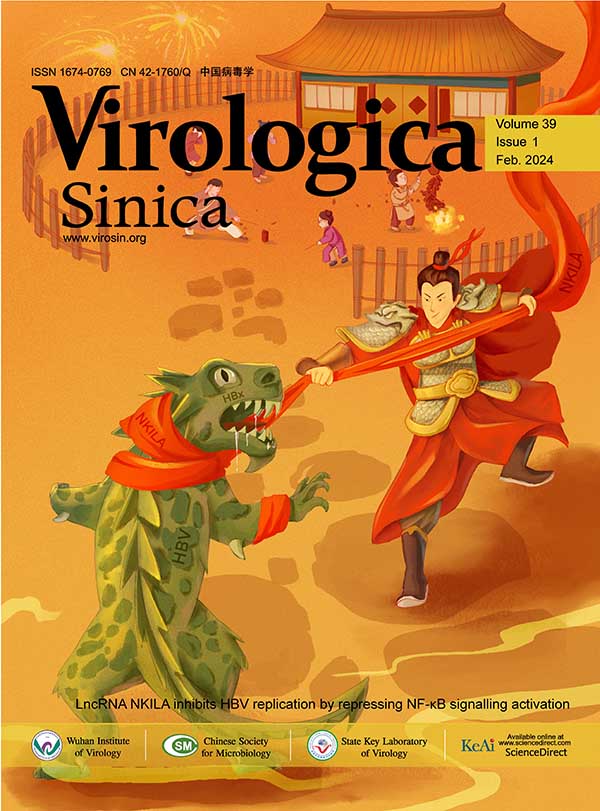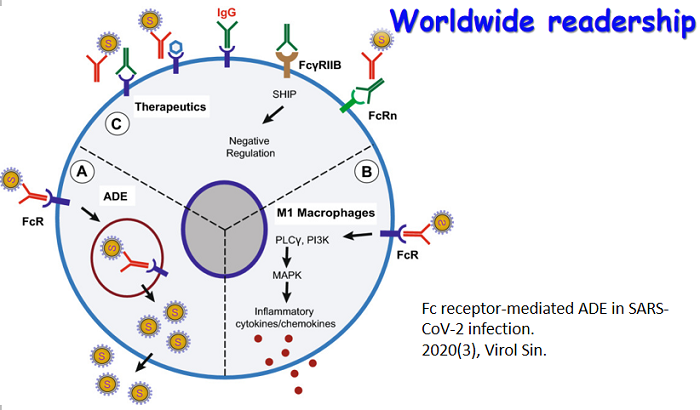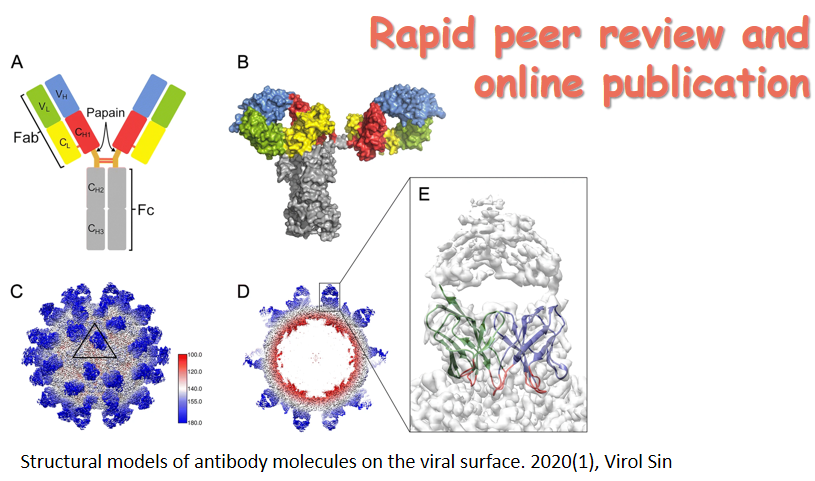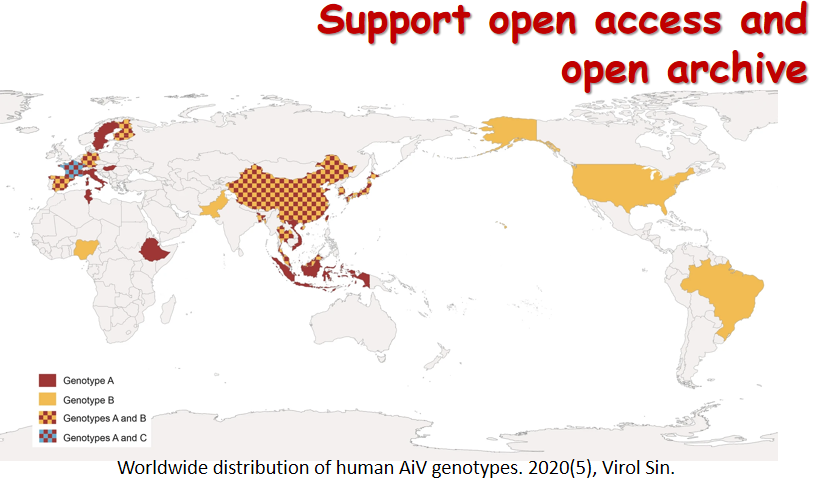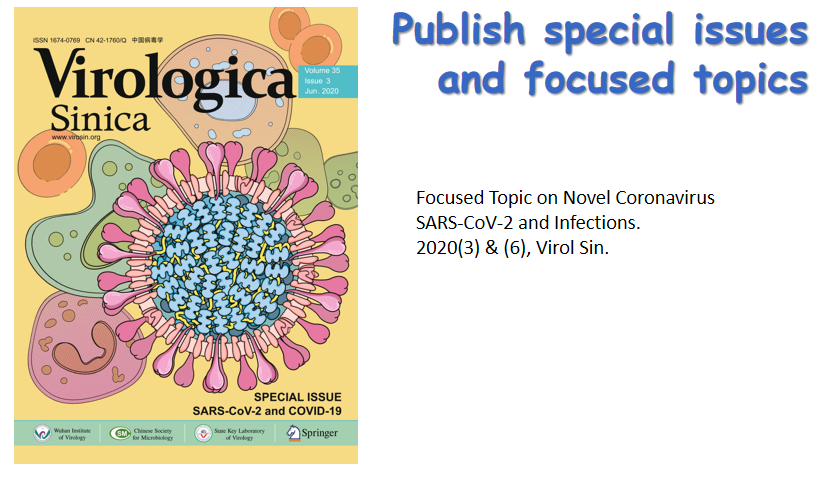|
The full-length gene of membrane protein ( M )of SARS coronavirus (SARS-CoV) was cloned using RT-PCR from the Vero-E6 cells infected with SARS-CoV (GD322 strain) and inserted into the multi-cloning site of the pPICZαB vector. The recombinant plasmid was transtormed into P. pastoris strain X-33 by electroporation and selected by Zeocin. Mut phenotype determination was performed on the yeast transformants and then expression of Mut~+ colonies were induced by methanol. The expressed products were analyzed by SDS-PAGE and Western blotting. Secreted expression was performed by screening Mut~+ colonies in the yeast (transformants). The molecular mass of the recombinant M protein was approximately 65 kDa and 42 kDa and secreted into culture medium when induced with methanol. The expressed protein was able to (react) with SARS convalescence polyclonal antibody.
Using a pair of specific primers designed according to the nucleotide sequence of Japanese encephalitis virus and Hameoaggulatinin of Human influenza virus from GenBank, the gene of JEV E protein’s main antigenic domain including the sequence of Human influenza virus ha gene was amplified with PCR method. The PCR product was successively cloned into pET-32a(+) vector to get a prokaryotic expression plasmid pET-EHA. After the positive plasmid was transformed into the host cell BL21(DE3) , the target gene was successfully expressed in the form of inclusion bodies when induced with IPTG. Western-blotting analysis proved the recombinant protein has good reactivity ability against JEV antibodies. The Latex Agglutination Test (LAT) method for the detection of JEV antibodies was established with the purified recombinant protein. The result indicated that LAT was a simple, rapid, sensitive, specific, inexpensive method which is suitable for detecting antibodies against JEV in serum and serological survey of JE .
Using a pair of specific primers designed according to the nucleotide sequence of Japanese encephalitis virus and Hameoaggulatinin of Human influenza virus from GenBank, the gene of JEV E protein’s main antigenic domain including the sequence of Human influenza virus ha gene was amplified with PCR method. The PCR product was successively cloned into pET-32a(+) vector to get a prokaryotic expression plasmid pET-EHA. After the positive plasmid was transformed into the host cell BL21(DE3) , the target gene was successfully expressed in the form of inclusion bodies when induced with IPTG. Western-blotting analysis proved the recombinant protein has good reactivity ability against JEV antibodies. The Latex Agglutination Test (LAT) method for the detection of JEV antibodies was established with the purified recombinant protein. The result indicated that LAT was a simple, rapid, sensitive, specific, inexpensive method which is suitable for detecting antibodies against JEV in serum and serological survey of JE .
To investigate the effect of interleukin-12 DNA immunization on immune responses induced by HIV-1 nucleic acid vaccine(DNA vaccine)and to explore new strategies for therapeutic HIV-1 DNA vaccine, Balb/c mice were immunized with pCI-neoGAG alone or co-administered with the DNA encoding for interleukin-12 (IL-12).Their sera were collected for analyzing anti-HIV antibody and IFN-γ by ELISA , and splenocytes were isolated for detecting antigen-specific lymphoproliferative responses and specific CTL response by MTT assay and LDH assay respectively.Our research showed that the anti-HIV antibody titers of mice co-immunized with pCI-neoGAG and the DNA encoding for interleukin-12 (IL-12) were lower than that of mice immunized with pCI-neoGAG alone(P0.01); In contrast ,the IFN-γ level of mice co-immunized with pCI-neoGAG and the DNA encoding for interleukin-12 was higher than that of mice immunized with pCI-neoGAG alone(P0.01).Furthermore, compared with mice injected with pCI-neoGAG alone, the specific CTL cytotoxity
VP1 is the major structural protein of the human polyomavirus BK and can be used for the generation of virus-like particles (VLP) in vitro by using recombinant baculoviruses. To determine the role of positively charged residues R-281, R-285, K-288, R-290, R-292, K-293, R-294, and K297 at the C terminal of VP1 in VLP formation and DNA binding, we separately changed the residue to alanine, and expressed VP1 protein. The results showed that substitution of K-288, R-290, R-292, K-293, R-294, and K297 with alaninecan still form VLP, but compared with wild type there were some differences in releasing VLP into culture medium and binding between major capsid proteins and cellular DNA . Interestingly,after substituting R-281 and R-285 with alanine, a few VLP in cell but no VLP were detected respectively. This study provides evidence that positively charged residues R-281 and R-285 are necessary to form VLP and the others can influence the binding between major capsid proteins and cellular DNA.
Bacterial and synthetic DNA containing CpG dinucleotides in specific sequence contexts are being tested as immune adjuvants in many disease settings. To study the immune responses induced by the CpG-enhanced plasmid DNA vector encoding hantavirus nucleiocapsid protein. BALB/c mice were immunized three times by intramuscular inoculations of the recombinant eukaryotic expression vector pcDNA3.1+S(ISS) at 2-wk intervals. To evaluate the humoral and cellular immune responses, antigen-specific lymphocyte proliferation and antibody production were assayed by MTT method and ELISA,respectively. In addition,the level of interleukin-4 and interferon-γ in the splenic lymphocytic cultured supernatant were detected with ELISA kit at various times. We found that the group immunized with pcDNA3.1+S(ISS) had more Ab response against NP compared with the control group over the period, specially at 35d and 42d,after the primary immunization. The antibody mean titre of the group immunized with pcDNA3.1+S(ISS) was increased to a
Non-structural and structural genes of Goose parvovirus (GPV) HG5/82 strain were amplified using polymerase chain reaction (PCR) method and cloned into the pMD18-T vector, respectively. The two fragments were sequenced and analyzed with reference GPV strains and Muscovy duck parvovirus(MDPV) strains. The results showed that the GPV ns gene is 1884bp and encoding 627 amino acids. The vp gene of HG5/82 strain is 2199bp and encoding 732 amino acids. The identity of partial VP3 genes between HG5/82 and MDPV is higher than that between GPV and other members of Parvovirinae. These results were also proved by the analysis of the VP3 gene. The high identity between GPV HG5/82 and MDPV indicated that they would be derived from the same ancestor.
Inhibitory effects of nitric oxide (NO) on Porcine parvovirus (PPV) infection on porcine kidney (PK-15) cells were studied in the paper. The results showed that production of NO was effectively induced in cell cultures treated with S-nitroso-N-acetylpenicllamine (SNAP) or L-arginine and replication of PPV was significantly inhibited by the addition of them in a dose-dependent manner.SNAP produced significantly higher amounts of NO and showed higher level of inhibitory effect on PPV replicaton than L-Arg at 100 and 200 μmol/L. Higher level of inhibition of viral production was also obtained when pretreated with SNAP at 6 h and 3 h before infection than added after infection,suggesting that the anti-PPV effects of NO occurred at the initial stages of PPV infection. In addition, the anti-PPV effects of L-arginine could be blocked by N~G-nitro-L-Arginine.
The matrix and the capsid are main structural proteins of Bovine immunodeficency virus (BIV) and play important roles in virus life cycle. In order to analyze these two proteins in vitro, we cloned these two genes into the prokaryotic expression vector pTXB and expressed in E. coli BL21(DE3) in a soluble form. After purification, the matrix without fusion peptide was obtained in milligram magnitude. The capsid was also expressed and purified in ten-milligram magnitude. We used the dissolvable BIV CA to immunized rabbit and got antiserum 53 d after first injection. Western blotting analysis showed that the antiserum could specifically recognize the native HIV CA protein. The protein could be used as the antigen to produce the antiserum and used in protein-protein interaction analysis.
faecal samples of dogs collected from August 2003~January 2004 were tested for the presence of Canine coronavirus (CCV) using a nested-PCR with conserved primers for the M gene.18 out of 43 diarrhea feces from dogs housed singly of Nanjing city were CCV positively, and the CCV detectable rate were positively correlated with seasons, it was higher in winter than that of in summer and autumn. 58 out of 69 feces from heathy dogs trained in groups were positive for CCV, and the positive ratio of samples of dog schools from Shenyang (34/39) was higher than that of from Nanjing(24/30). Sequence analysis of 4 CCV M gene fragments, two from positive diarrhea samples of Nanjing and two from heathy samples of Shenyang, showed the presence of the CCVs with high similarity (94.8%~96.7%) to the CCV of giant panda from China in the GenBank. All the CCVs detected in this survey were type Ⅱ confirmed by a PCR gene typing.
The genome of BFDV strain HBYM02 isolated from Hubei province was sequenced and analyzed. The sequence suggested BFDV isolated from different hosts belonged to one genotype. A phylogenetic tree based on the genomic nucleotide sequences of seven isolates was constructed. This tree showed two main branches. Taking into account of the relation of the hosts, the tree suggested BFDV formed a host-specific evolution, and it was impossible to delineate a geographically based evolution.
An infectious bursal disease virus (IBDV), isolated from Dongying city in Shandong province, was propagated several generations in SPF embryos and then turned to cell culture. The chickens were immunized by 20th, 21st, and 25th generation cell viruses in different doses at the age of 7 d and 14 d, and then were challenged at the age of 35 d. The titers of antibody to IBDV were detected before inoculation and challenge. According to the titers of antibody against IBDV after inoculation, the morbidity and mortality after challenge, the ratios of immune organ to body weight, the damage of immune organ, the results demonstrated that all the viruses had good immunogenicity when the chickens were vaccinated at 14d with the dose of 3000TCID\-(50) by the primary vaccine, and the chickens gained better immune protection. The 20th generation had durative pathogenicity to chickens when inoculated at 7d and caused immunosuppression to ND immune responses while 21st and 25th had transitory tissue damnification and immunos
Based on t he infectious clone p FD328 wit hin EIAV f ull2lengt h genome , and according to the variation of structural genes during vaccine preparation , several chimeric infectious clones involved in gag and env genes , modified by overlap PCR site2 directed mutagenesis , were constructed successfully. These clones were used to t ransfect fetal donkey dermal (FDD) cell s and donkey differentiated monocyte macrop hages (DL ) , and their infectious characteristics were monitored by RT-PCR and rever set ranscriptase activity assay. The results indicated that after five generations passaged in FDD cell s t hen five generations in differentiated monocyte2macrop hages , RT activity and RT2PCR were found to be obviously positive in cell cult ure supernatant and viruses particles were al so clearly observed under electron microscope. Nevertheless , t he final viral titer s of these artificial viruses in DL culture were obviously higher than that in FDD culture. Analysis of the replicative characteristics between these chimeric viruses and t heir parental virus pL GFD328 showed that the formers slightly delayed in replication compared with the latter . All this provides a solid basis for further study of the pathogenic mechanism and immune protection against Chinese equine infectious anemia virus.
A pair of primers was designed to amplify vp4 gene of major antigen site (1-756 bp) of JL94 isolate. The sequence was analyzed in comparison with the VP4 amino acid sequences of two reference porcine rotavirus. The amino acid sequences were 96.43% and 67% correspondingly. Notably, the most divergence of amino acid sequence is located in a region delimited by aa81-aa207. The vp4 gene was inserted into expression plasmid pMel BacA. pMel BacA and Bac-N-blue DNA were cotransinfected insect cell Sf9. After 3 time plaque, reconstitution virus affected Sf9 and expresed in the cell. It indicated that the 30kDa product of the vp4 gene was 20% of total cell protein. Western blotting and neutralization test continmed that product had a nice biological activity. This study provides the basis for PRV identification, molecular epdiemiology investigation, and research of diagnostic reagent and genetic engineering vaccine
Variations in the amino acid sequence of Foot-and-mouth disease virus (FMDV) structural proteins are the molecular basis for the antigen diversity of the virus. Majority of antigenic sites for the virus neutralization are present on VP1, the major immunogenic protein. However, a few conformational epitopes are present on the structural proteins VP2 and VP3. The nucleotide sequence encoding all four structural proteins(P1 region) of FMDV type Asia1 YNBS/58 was determined. The P1 region of type Asia1 YNBS/58 is 2199 bp in length and codes for a polypeptide of 733 amino acids. The structural protein of vp4,vp2,vp3 and vp1 gene consists of 255,657,654,633 bp respectively. The nucleotide sequence identity of p1 gene between YNBS/58 and Ind63/72, Pka3/54, Israel, China/99, C1/Germany, A22, ZIM7/83/2 strains is 88.4%,86.0%,89.3%,68.6%,67.6%,66.8% and 50.3%, and the amino acid identity is 94.1%,93.2%,95.1%,79.9%,77.0%,76.5%,58.1%. The variations are unequally distributed among the four structural proteins of YNBS/58
In order to investigate the antiviral activity of 112 kinds of nanomaterials and give theoretical gist for developing new antiviral nanomaterials, we used various nanometer catalysts inhibitory to Parainfluenza virus, Herpes simplex virus types 1, Adenoviruses types 1 and 5 in given time and examined their sorption and virucidal activity through the haemagglutination test and CPE reduction respectively.We also observed their sorption and virucidal activity to viruses under the electron microscope. We found that in the 112 nanometer catalysts tested, the strong, moderate and weak sorption nanometer catalysts were 29,36 and 47 respectively by the haemagglutination test. Among them there were 13 sorts of strong sorption nanometer catalysts whose sorption rate were between 87.5% to 93.75% on parainfluenza virus, and the best was AB-24.
According to the nucleotide sequences of the vt1 and vt2 toxin genes in GenBank, four pair of primers were designed and synthesized. vt1 and vt2 were detected in E.coli O157:H7 strains. Bacteriophage was induced and released from the strain only carrying vt2. Phage DNA was extracted and used as PCR template for the detection of the vt2, vt2-A and vt2-B genes. The purified vt2-A and vt2-B fragments were inserted into pMD18-T vector. Sequencing proved that two sequences were genes of subunit A and B of vt2. The homologies of two sequences compared to their corresponding sequences coding VT2 toxin in GenBank (accession numbers X07865, NC_002655, BA000007, AF291819) were 98%~99%, 96%~100%,respectively. Our results revealed that vt2 gene was encoded by bacteriophage, which provides a foundation for further research on horizontal transmission of VT phage carrying virulent gene.
There are two kinds of membrane fusion proteins encoded by baculovirus: GP64 and F protein. The membrane fusion protein of group I NPV is GP64, while group II NPV is F protein. In this paper. we tried to answer whether GP64 can be expressed and assembled into the BV of Group II NPV. By using Bac-to-Bac system, we successfully constructed recombinant baculoviruses HaSNPVgp64~+egfp~+ possessing GP64 of AcMNPV and EGFP, and HaSNPVegfp~+ with an EGFP as control. Western blotting analysis indicated that GP64 was expressed in HzAM1 cells infected with HaSNPVgp64~+egfp~+ and was packaged into progeny BVs.
The gene fragment of Avian influenza virus (AIV) was amplified by RT-PCR. The results of sequence analysis showed that high homology(97%) exists among duck, goose and Human influenza virus in Hongkong AIV in 1997, indicating that there are close relationship among these ha genes. The ha gene are expressed efficiently in E.Coli.
Through analyzing the whole cDNA sequence of the sporadic Hepatitis E virus gene and comparing it with other genotypes,we can understand its variability.We used RT-nPCR to assay the HEV RNA of a patient who was diagnosed with sporadic hepatitis E virus. We designed the primers according to different segments respectively to amplify the whole gene,and sequenced the product . The whole cDNA of HEV contains 7139bp,which consisits of 5’-UTR(nt 1-9),ORF1(nt 10-5130,1706aa),ORF2(nt 5127-7151,674aa),ORF3(nt 5155-5499,114aa),and 3’-UTR(nt 7152-7193). The identity of nucleic acid between it and genotypeI, genotypeII, genotypeIII, genotypeIV is 73.2%~74.1%,72.4%,73.95%~75.2% and 83.9%~85.6%,respectively. Analyzing the phylogenetic tree showed that it is relevant to HEV genotypeIV line. Sporadic hepatitis E virus in Changchun is HEV IV,and it has higher heterogeneity.
On the basis of genomic sequence of PCV-2 in the GenBank, two primers for amplification of PCV-2 specified fragments were designed and PCR assay for the detection of PCV-2 was established,the kit was used to detect PCV-2. The kit’s sensitivity, specificity and expiration date were tested. The result suggested the kit had high sensitivity and specificity. It could be stored at least for one year at -20℃.
A 0.5kb antisense RNA fragment was designed targeting the 5’ non-coding region (NCR), translation initiation site and potential transcriptional active region of the sole immediate early gene(IE180) of Pseudorabies virus(PRV). The antisense RNA fragment was amplified by PCR and inserted into the downstream of hCMV IE promoter/enhancer of the eukaryotic expression vector pCI-neo. The resulting antisense RNA expression plasmid(pCI-0.5) was transfected into PK-15 cells and the transfected cells were selected by G418.The expression of antisense RNA was confirmed by RT-PCR. In order to assess the antiviral potency of the cell lines expressing the antisense RNA, the antisense RNA cell lines and the control cell lines were infected with 0.1 pfu of PRV strain Ea per cell. The infected supernatant were collected at different time points post-infection(p.i.) and the TCID\-(50) were further determined. The data showed that the cell lines expressing the antisense RNA could markedly inhibit the replication of PRV. The vira ˎ̥,Verdana,Arial">titers in ˎ̥,Verdana,Arial; mso-font-kerning: 1.0pt; mso-bidi-font-family: 'Times New Roman'; mso-fareast-font-family: 宋体; mso-ansi-language: EN-US; mso-fareast-language: ZH-CN; mso-bidi-language: AR-SA">cells expressing the antisense RNA was 1562 fold less than control cells at 40 hp i.







